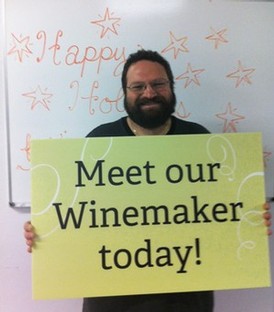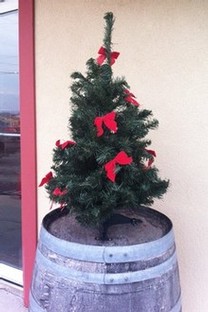It's a Winemaker's Life in December
The fermentations of the 2012 wines can dwell into December for some batches of Riesling and Late harvests. For the white varietals, it is not a bad thing to have a slow fermentation: it gives the wine more complexity and preserves the volatile aromas. As long as the sugar content is going down, I am not very worried. Some winemakers have their wines ferment until late spring.
The white wines which have completed the alcoholic fermentation are then racked off the lees a couple of times before being cold and protein stabilized. By chilling the wines at around 28 degrees F, tartaric acid and potassium ions naturally contained in grape juice react together and form tartrates, the little crystals you might have seen in a white or rosé wine that was thrown in the freezer for a quick chill, or the cork of a bottle of red wine. Tartrates are not armful; they just look weird in a clear white wine and feel like sand in your mouth. The tartrates settle to the bottom of the tank and are removed from the wine. Heat or protein stability is obtained by getting rid of the proteins contained in the wine by adding bentonite, a sort of clay. The proteins weighed down by the bentonite settle to the bottom of the tank and are removed from the wine. After a couple of filtrations, the heat and cold stable wine is ready to be bottled during the summer.

The red wines don’t have to go through heat and cold stabilization, although some winemakers may choose to do so. Over the winter, the reds go through a secondary fermentation, called Malo-lactic fermentation. Malo-lactic bacteria eat malic acid, naturally contained in grape juice, and produce lactic acid, which is a softer acid than malic acid. This secondary fermentation makes the wine more stable against spoilage and makes the wine softer. We do not have our white wines go through Malo-lactic fermentation in order to preserve the natural crisp acidity of the Rieslings and chardonnays and other white wines. It’s all about balance!
In the vineyard, we are plowing to cover the base of the trunks of the vines to protect them from the harsh winter. We are fixing wires, posts and such before the soil freezes. Pruning starts with the New Year and lasts throughout March.
For the Holidays, my wife and I return to Long Island where her relatives reside. We traditionally celebrate with the Italian “Feast of the seven Fishes.” You might have guessed it: it’s all seafood! I usually bring the wines, of course: Heron Hill Muscat, Dry and Semi-Dry Riesling, Ingle Vineyard Cabernet Franc and Eclipse Red for the red wine drinkers, and I better not forget my mother in law’s favorite: Late Harvest Vidal Blanc. It is the occasion for us to see all our cousins, at least once a year, catch up, and have a great time, playing pool and poker. These guys can be tough! Happy Holidays, and drink responsibly.
